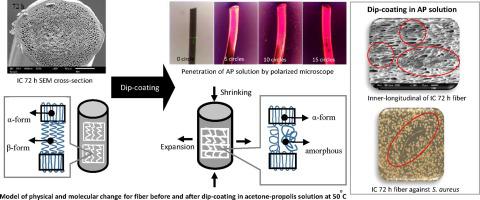当前位置:
X-MOL 学术
›
Eur. Polym. J.
›
论文详情
Our official English website, www.x-mol.net, welcomes your
feedback! (Note: you will need to create a separate account there.)
Characteristic changes in PHBH isothermal crystallization monofilaments by the effect of heat treatment and dip-coating in various solvents
European Polymer Journal ( IF 5.8 ) Pub Date : 2020-07-01 , DOI: 10.1016/j.eurpolymj.2020.109808 Rina Afiani Rebia , Kaho Shizukuishi , Toshihisa Tanaka
European Polymer Journal ( IF 5.8 ) Pub Date : 2020-07-01 , DOI: 10.1016/j.eurpolymj.2020.109808 Rina Afiani Rebia , Kaho Shizukuishi , Toshihisa Tanaka

|
Abstract PHBH monofilament was fabricated by the melt-spinning process followed one-step-drawing after isothermal crystallization (IC) near Tg for 24, 48, and 72 h. A feasible way to improve the functionality of monofilament is the incorporation of natural compounds as an antibacterial reagents such as propolis. Moreover, various solvents were used to evaluate the penetration of propolis into PHBH IC monofilaments. The effect of heat treatment by various solvents such as acetone, ethanol, hexane, propanol as well as water, and air in physical change of PHBH IC fibers have been studied. The change in shrinkage and diameter of fibers found to be highly dependent on the temperature of each solvents. The dip-coating as a method to incorporate propolis reagent in ethanol and acetone solution was also evaluated. Acetone-propolis (AP) solution showed excellent penetration into PHBH IC monofilaments. Furthermore, by dip-coating for 5, 10, 15 circle times in AP solution at 50 °C affected the physical properties, mechanical properties, and inner structure of PHBH IC monofilaments. The length of IC 24 and 72 h fibers after dip-coating for 15 circle times shrank 25 and 26% from the initial length, respectively. Thus, the diameter of IC fibers expanded and the weight of IC fibers increased as a consequence of the propolis reagent settle in voids of IC monofilaments. IC 24 and 72 h monofilaments after dip-coating showed a reduction in tensile strength and an increase in elongation at break. The crystallinity (WAXD) of IC 24 and 72 h monofilaments was decreased and led to an increase in the thickness of the lamellar crystal (SAXS) by applying dip-coating for 15 circle times. The antibacterial test demonstrated that PHBH IC fibers containing propolis resulted in inhibitors against the growth of Staphylococcus aureus. Additionally, the characteristic changes in PHBH IC fibers can apply for reference as further research regarding drug delivery or the dyeing process by various solvents.
中文翻译:

PHBH等温结晶单丝在各种溶剂中热处理和浸涂作用下的特性变化
摘要 PHBH 单丝是在 Tg 附近等温结晶 (IC) 24、48 和 72 小时后,通过熔融纺丝工艺和一步拉伸制成的。提高单丝功能的一种可行方法是加入天然化合物作为抗菌试剂,如蜂胶。此外,使用各种溶剂来评估蜂胶对 PHBH IC 单丝的渗透。研究了丙酮、乙醇、己烷、丙醇以及水、空气等多种溶剂热处理对PHBH IC纤维物理变化的影响。发现纤维收缩率和直径的变化高度依赖于每种溶剂的温度。还评估了浸涂作为将蜂胶试剂掺入乙醇和丙酮溶液的方法。丙酮-蜂胶 (AP) 溶液对 PHBH IC 单丝表现出优异的渗透性。此外,通过在 50°C 的 AP 溶液中浸涂 5、10、15 圈时间,影响了 PHBH IC 单丝的物理性能、机械性能和内部结构。IC 24 和72 h 纤维在浸涂15 圈后的长度分别比初始长度缩短了25% 和26%。因此,由于蜂胶试剂沉淀在 IC 单丝的空隙中,IC 纤维的直径扩大,IC 纤维的重量增加。浸涂后的 IC 24 和 72 小时单丝显示拉伸强度降低和断裂伸长率增加。IC 24 和 72 h 单丝的结晶度 (WAXD) 降低并通过浸涂 15 圈导致层状晶体 (SAXS) 的厚度增加。抗菌试验表明,含有蜂胶的 PHBH IC 纤维可抑制金黄色葡萄球菌的生长。此外,PHBH IC 纤维的特性变化可作为进一步研究药物传递或各种溶剂染色过程的参考。
更新日期:2020-07-01
中文翻译:

PHBH等温结晶单丝在各种溶剂中热处理和浸涂作用下的特性变化
摘要 PHBH 单丝是在 Tg 附近等温结晶 (IC) 24、48 和 72 小时后,通过熔融纺丝工艺和一步拉伸制成的。提高单丝功能的一种可行方法是加入天然化合物作为抗菌试剂,如蜂胶。此外,使用各种溶剂来评估蜂胶对 PHBH IC 单丝的渗透。研究了丙酮、乙醇、己烷、丙醇以及水、空气等多种溶剂热处理对PHBH IC纤维物理变化的影响。发现纤维收缩率和直径的变化高度依赖于每种溶剂的温度。还评估了浸涂作为将蜂胶试剂掺入乙醇和丙酮溶液的方法。丙酮-蜂胶 (AP) 溶液对 PHBH IC 单丝表现出优异的渗透性。此外,通过在 50°C 的 AP 溶液中浸涂 5、10、15 圈时间,影响了 PHBH IC 单丝的物理性能、机械性能和内部结构。IC 24 和72 h 纤维在浸涂15 圈后的长度分别比初始长度缩短了25% 和26%。因此,由于蜂胶试剂沉淀在 IC 单丝的空隙中,IC 纤维的直径扩大,IC 纤维的重量增加。浸涂后的 IC 24 和 72 小时单丝显示拉伸强度降低和断裂伸长率增加。IC 24 和 72 h 单丝的结晶度 (WAXD) 降低并通过浸涂 15 圈导致层状晶体 (SAXS) 的厚度增加。抗菌试验表明,含有蜂胶的 PHBH IC 纤维可抑制金黄色葡萄球菌的生长。此外,PHBH IC 纤维的特性变化可作为进一步研究药物传递或各种溶剂染色过程的参考。











































 京公网安备 11010802027423号
京公网安备 11010802027423号